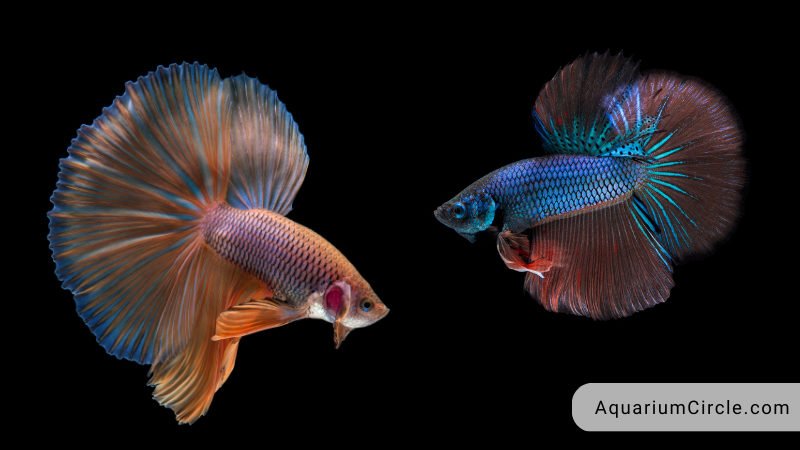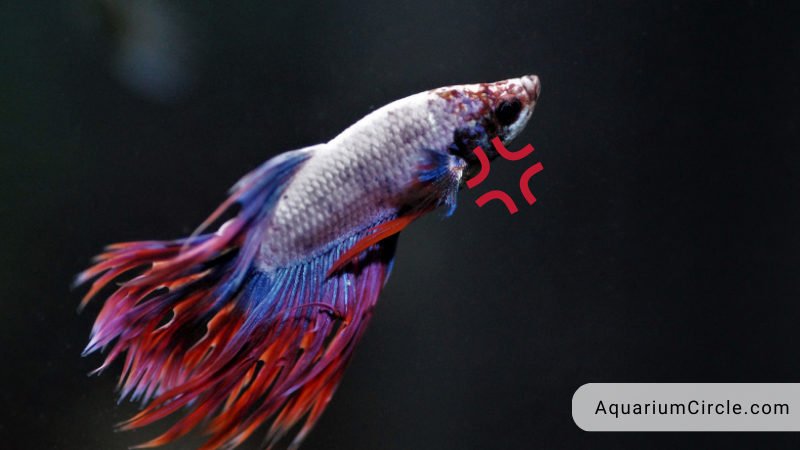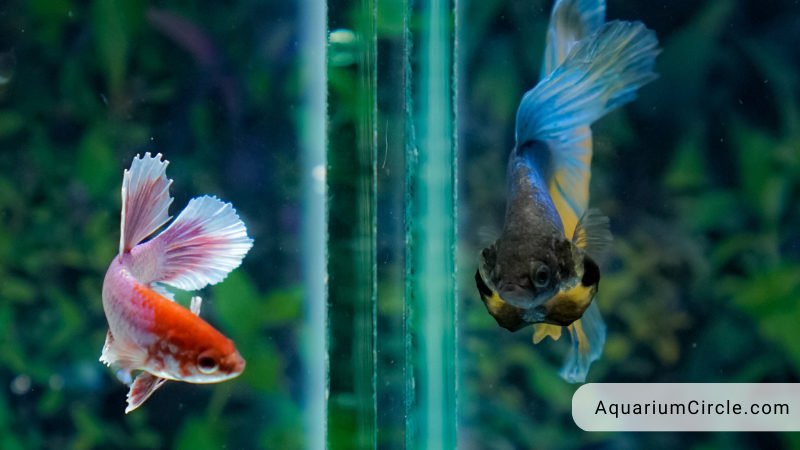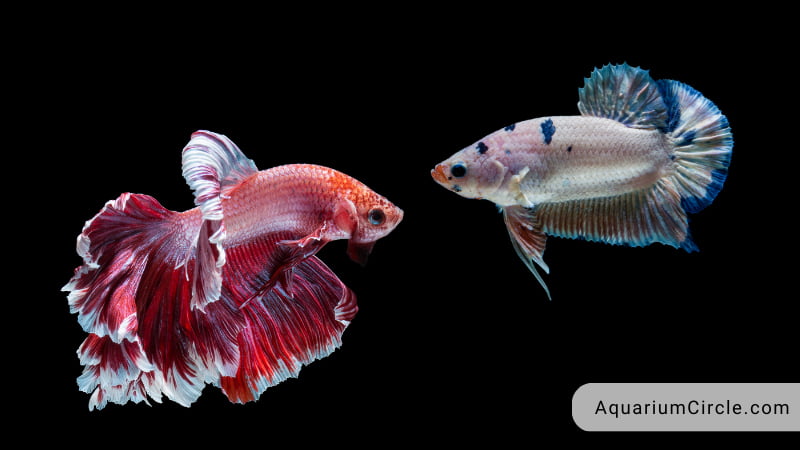Betta fish are widely considered to be one of the most stunning fish species that one can own, with their colorful fins and tails and lively personalities. The idea of having both male and female bettas in the same fish tank may seem enticing, but the question remains: can male and female betta fish live together harmoniously?
In short, male and female bettas can coexist temporarily during breeding periods, but they should not be housed together in the same aquarium for an extended period. The aggressive nature of male bettas makes it difficult for males and females to coexist peacefully, and there are many risks associated with housing them together in a long-term situation. Even betta harem tanks, which can sometimes work, have inherent dangers.
If you are considering introducing your male and female betta fish for breeding purposes, or you are intrigued by the concept of a betta harem tank, there are several important factors to consider before proceeding. Our guide will help you navigate the complexities of this process, ensuring that you make informed decisions that prioritize the safety and wellbeing of your beloved betta fish.
See also:
- Top 3 Most Crucial Things To Know Before Getting A Multiple Betta Fish Tank
- How To Breed Betta Fish At Home? Detailed Step-by-step Guide For You
- How Many Betta Fish In A 10 Gallon Tank: Useful Guide
Can Male And Female Betta Fish Live Together?
Male and female betta fish should not be housed together in the same tank for an extended period of time. This is because bettas are highly territorial and aggressive by nature, and males and females can be particularly hostile towards each other.
In the wild, male betta fish will aggressively defend their territory, which can include large areas of water. They will fiercely attack any other male bettas that enter their territory, and will also attack females during the breeding process. This behavior is instinctive, and even domesticated bettas will exhibit this territorial aggression.
While it is possible for a male and female betta to coexist temporarily during the breeding process, housing them together in the same tank on a long-term basis is not recommended. This is because even if the male and female are compatible at first, their behavior may change over time as they mature, leading to aggression and potentially serious injury.
Physical And Behavioral Differences Between Male And Female Bettas

If you still want to keep male and female betta together, you have to understand the physical and behavioral differences between male and female bettas so that you can provide them with appropriate care and ensuring their health and happiness.
When it comes to physical differences, male betta fish tend to be slightly larger than females, with a more streamlined and muscular body shape. They also have longer, more elaborate fins and tails, which are typically more vibrant and varied in color than those of females. Female bettas, on the other hand, tend to have a rounder and plumper body shape, with shorter, less elaborate fins and tails. While they may not be as showy as their male counterparts, female bettas can still be quite beautiful, with a variety of colors and patterns.
In terms of behavior, male and female bettas exhibit some distinct differences. Males are notoriously territorial and aggressive, particularly towards other males. If there are two male betta fish in the same tank, they will fiercely defend their territory, which can include large areas of water, and will attack other male bettas or even females during the breeding process. Males are also more active and playful than females, which tend to be more docile and relaxed.
Females, on the other hand, are generally more tolerant of other fish in the tank, although they can still be territorial at times. They tend to be less aggressive than males, and may even tolerate the presence of other females in their tank. Female bettas are also less active than males, and may spend more time resting or hiding.
How To Introduce A Male And A Female Betta To Each Other?

Introducing one male and one female betta to each other can be a delicate process, as bettas are naturally territorial and can be aggressive towards one another. Here are some steps to follow when introducing a male and female fish to each other:
- Prepare the tank: Make sure that the tank size is large enough to accommodate both bettas and has plenty of hiding places and plants to break up the line of sight between the two fish. It is also important to ensure that the water temperature, pH levels, and other water parameters are appropriate for both bettas.
- Introduce the bettas: To introduce the bettas to each other, it is recommended to place them in separate containers and float them in the tank for a few hours. This allows them to get used to each other’s presence and become acclimated to the new environment.
- Monitor their behavior: Once you release the bettas into the tank, closely monitor their behavior for signs of aggression or stress. Some flaring or chasing is normal, but if the behavior becomes too aggressive or one fish appears to be significantly stressed, it may be necessary to separate them.
- Watch for signs of breeding: If the bettas begin to exhibit breeding behavior, such as the female laying eggs or the male building a bubble nest, this is a sign that they may be compatible and can be left together to breed.
- Be prepared to separate them: If the bettas are not compatible or become too aggressive towards each other, it may be necessary to separate them into different tanks for their safety and wellbeing.
How Can You Put A Male And Female Betta Fish Together Peacefully?
Betta fish are known for their aggressive behavior and as a general rule, they should not be housed together. However, if you do choose to house multiple bettas in the same tank, it is important to carefully observe their behavior and avoid placing particularly hostile or aggressive individuals together. These fish can disrupt the peaceful tank environment and increase stress levels for other fish. If you notice any signs of conflict or aggression, it is important to separate the bettas before a full-scale fight breaks out. By carefully monitoring your betta fish and taking steps to avoid conflict, you can help ensure a harmonious and stress-free living environment for your aquatic pets.
In addition to careful observation and separation of aggressive bettas, there are several other important considerations to keep in mind when attempting to house male and female bettas together:
- Firstly, make sure that there is plenty of space in the tank for all bettas to establish their own territories and minimize the risk of conflict. Crowding bettas in a small space can increase stress levels and make aggressive behavior more likely.
- Secondly, it is important to keep the tank clean and well-maintained, with minimal clutter or debris that could cause stress or aggression. Regular water changes and filtration can help maintain a healthy and stress-free environment for your bettas.
- Thirdly, providing each betta with their own feeding area can help minimize conflict and ensure that each fish gets the nutrition they need.
- Finally, regular monitoring of betta behavior is essential to catch any signs of aggression or conflict early. If necessary, separating bettas into different tanks may be the best option for their safety and wellbeing.
By carefully considering these factors and taking steps to create a calm and stress-free environment for your bettas, you can help ensure that your male and female bettas can live together peacefully and happily.
See also: Do Betta Fish Like Light? Your Answer Is Right In This Post!
What Will Happen If Your Male Betta Doesn’t Get Along With Your Female One?

If your male betta doesn’t get along with your female betta, it can result in aggression, stress, and even injury or death. Betta fish are known for their aggressive nature, especially when it comes to their own species. In the wild, male bettas will fight for territory and mating rights. When housed in a small tank or aquarium, these natural instincts can cause conflicts between male and female bettas.
If a male betta doesn’t get along with a female betta, it can lead to physical aggression, such as biting, chasing, and fin nipping. This can cause injury and stress to both fish, and can even result in death if the aggression is severe enough. In addition to physical aggression, male and female bettas may display territorial behavior, such as flaring and posturing, which can also cause stress and anxiety.
What should you do in case your two bettas can’t stay in the same tank together?
If your male betta does not get along with your female betta, it is important to take steps to ensure the safety and wellbeing of both fish. Here are some actions you can take:
- Separate the bettas: The first step is to separate the male and female bettas into separate tanks to prevent any further aggression or harm.
- Reassess the tank setup: Evaluate the tank setup to determine if there are any factors contributing to the aggression, such as insufficient hiding places or an overcrowded tank. Make adjustments as necessary to create a more peaceful environment for both bettas.
- Try reintroducing the bettas: If you still want to keep both bettas, you can attempt to reintroduce them to each other at a later time. Make sure to follow proper introduction techniques and closely monitor their behavior for signs of aggression or stress.
- Consider other tank mates: If the bettas are still unable to coexist peacefully, consider adding other tank mates to the tank to distract them from each other. Just be sure to choose tank mates that are compatible with bettas and won’t pose a threat to their safety.
- Seek advice from a professional: If you are having trouble getting your bettas to get along, it may be helpful to consult with a veterinarian or experienced fish keeper to get advice on how to properly care for your fish and create a peaceful environment for them.
Remember, it is not always possible for male and female bettas to coexist peacefully in the same tank. In some cases, it may be best to keep them separate to prevent injury or stress.
Alternatives To Housing Male And Female Bettas Together

While it may be tempting to house male and female bettas together, it is important to remember that they are known for their aggressive nature and territorial behavior. If you are concerned about the safety of your fish or have had trouble getting them to coexist peacefully, there are several alternatives to consider.
- Keep Them In Separate Tanks: The most obvious alternative is to keep a male and female betta in separate tanks. This allows each fish to have its own territory and reduces the risk of aggression and stress. Each tank should be equipped with a filter, heater, and appropriate decor to create a comfortable and stimulating environment for your betta.
- Try A Female Sorority: A betta sorority is a group of female bettas that are housed together in a single tank. While female bettas can be aggressive towards each other, they are generally less aggressive than males and can coexist peacefully if they are introduced slowly and have enough space. It is important to note that not all female bettas will get along, so it is best to start with a small group and monitor their behavior closely.
- Consider Other Species: If you want to add more fish to your tank but are concerned about the aggression of male and female bettas, there are several other species that can coexist peacefully with bettas. Some popular options include neon tetras, guppies, and corydoras. It is important to research each species carefully and ensure that they are compatible with bettas before adding them to your tank.
- Use a Tank Divider: If you have a larger tank, you can create divided sections to house multiple bettas. This allows each fish to have its own space while still being in the same tank. Dividers can be made from acrylic or glass and should be securely attached to the tank to prevent any fish from getting through.
In conclusion, while male and female bettas can sometimes live together, it is important to consider the risks and alternatives before making a decision. Keeping bettas in separate tanks, trying a betta sorority, considering other species, and creating divided tanks are all viable alternatives to housing male and female bettas together. By providing your fish with a safe and comfortable environment, you can ensure that they live happy and healthy lives.
See also: Guppy Fish With Betta: The Best Way To Get Your Aquarium Started
Video About Male And Female Betta Fish Live Together
FAQs
Can male and female betta fish live together?
No, male and female betta fish should not be housed together due to their aggressive nature towards each other.
Why are male and female betta fish aggressive towards each other?
Betta fish are territorial by nature and will aggressively defend their space from other bettas, particularly those of the same sex.
Can male and female betta fish live together if they are siblings?
No, even siblings can become aggressive towards each other as they mature and become sexually mature.
Can other types of fish be housed with male and female betta fish?
Yes, but it is important to choose appropriate tank mates that are not too small, too aggressive, or too brightly colored, as these can trigger the betta fish’s aggressive instincts.
References

Annette M. Chaney is an experienced marine biologist with over 20 years of experience as an aquarist and fishkeeper. She started her first aquarium at a young age, filling it with frogs and goldfish obtained from the ten-cent pet store.
Annette grew up caring for and breeding African Cichlids, which led to a hobby in high school that doubled as a profitable means. Attending Reed College gave her time to solidify herself as an accomplished aquarium caretaker with an eye for sales. After that, from 2009 – 2013, she studied at Roger Williams University – one of the most prestigious universities for Aquaculture and Aquarium in USA. She is the founder of AquariumCircle since 2010.
